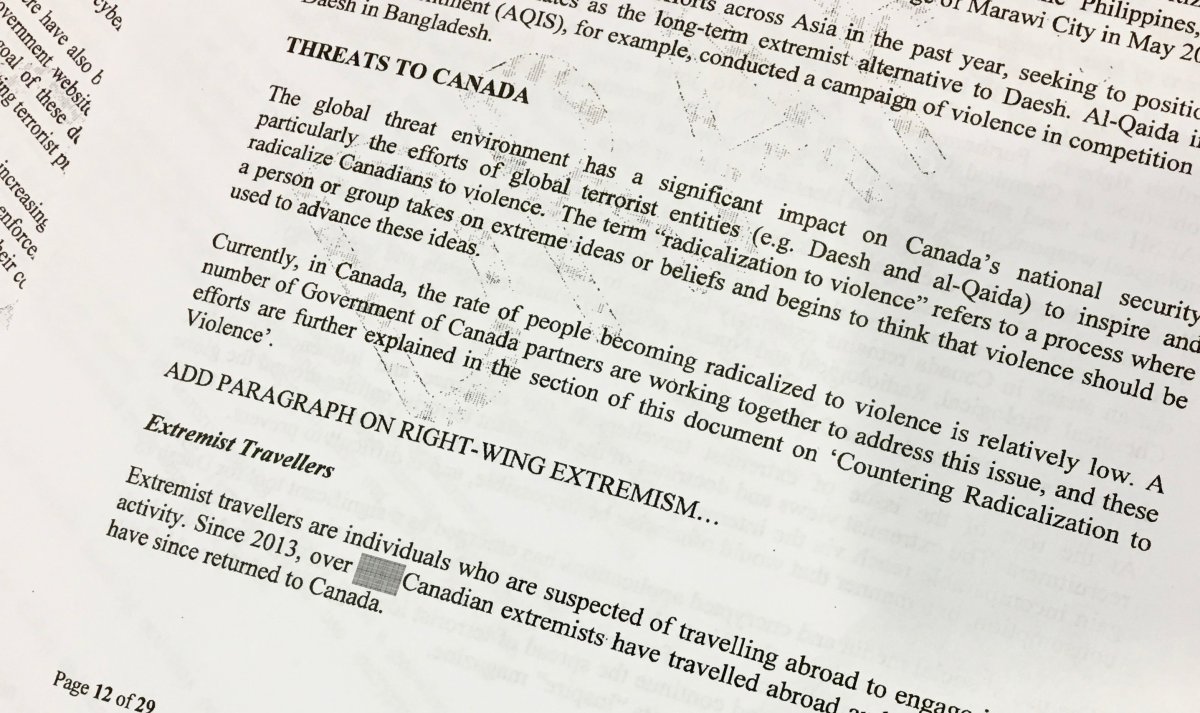Government documents obtained by Global News reveal disagreements between police, intelligence and public safety officials over how to describe the Canadian far right.

Internal debate over right wing extremism arose when Public Safety Canada consulted with federal agencies on the 2017 Public Report on the Terrorist Threat to Canada.
As the first threat report since the attack at a Quebec City mosque that left six dead, officials decided to address the far right, writing in an early draft, “Add paragraph on right-wing extremism.”
But hundreds of pages of documents obtained under the Access to Information Act show the backroom discussions that occurred over basic questions about Canada’s extreme right.
Whether the far right could be categorized as a terrorist threat, its size and whether it was growing were disputed topics over the months that the report was being drafted last fall.
“Within the broader context of extremism in Canada, the number of right-wing extremists who promote or are willing to engage in politically-motivated violence is extremely small,” read an emailed contribution to the report that appears to have been written by the Canadian Security Intelligence Service.
But while Public Safety Canada initially included the statement in the report, it was later changed from “extremely small” to “quite small,” and then cut altogether.
CSIS also took issue with calling right-wing extremism “a growing concern in Canada,” saying that was a “subjective statement” and asking, “What is your facting for this?”
Public Safety officials nonetheless kept the line.
Another official who reviewed a draft of the report questioned why far right extremism was listed under the heading Principal Threats to Canada. “Is far-right a ‘principal threat’ to Canada? Good that it is outlined in this document, but may want to revisit how this is framed.”
WATCH: A look at terrorism in Canada

The RCMP also questioned whether the far right should be included in the section on principal terrorist threats. “Should this be in a terrorism section or an ideological violence section,” a senior officer wrote. “Note there are no listed far right groups in Canada, so this is suggesting that despite the lack of listing there are far right terrorist groups.”
The back-and-forth over the report took place amid a broader debate over the priorities of Canada’s counter-terrorism agencies that recently flared again following the Toronto van attack that killed 10.
LISTEN: Stewart Bell speaks with 630 CHED’s Ryan Jespersen
While CSIS and the RCMP are focused heavily on thwarting attacks inspired by ISIS and Al Qaeda, some are calling on them to place more emphasis on other threats, such as the racist, anti-immigrant far right.
Ryan Scrivens, a leading academic expert on the far right, said CSIS viewed jihadists as a national security threat and right wing extremists (RWEs) as “less of a threat, a community threat at best.”
“To some extent, this is true, but we’ve seen RWEs in Canada terrorize countless communities and engage in some of the most deadly attacks in Canada, so I’ve always been baffled by this distinction,” said Scrivens, a Horizon Postdoctoral Fellow at Concordia University.
He said that while it was correct that only a small number of Canadians engaged in right wing violence, the number that held radical views was not and violence still occurred.
In its comments as the 2017 threat report was being assembled, CSIS took issue with a section it felt equated Al Qaeda and the so-called Islamic State (or Daesh) with right wing extremism (RWE) and left wing extremism (LWE).
“The threat from Daesh and Al Qaeda is not the same as the threat from RWE/LWE,” CSIS wrote.
Elsewhere, CSIS challenged statements in the draft report about the far right threat, asking: “What is your facting for this? Are you referring to: criminal acts, terrorism, or legitimate (albeit hateful) acts of public protest? You could say: ‘academics argue that’ or ‘Vice News claims’ or there has been an increase in the number of hate related incidents reported to police as per Stats Canada data.'”
Public Safety Minister Ralph Goodale’s opening remarks on the far right also evolved through drafts of the report. Initially he wrote that “security and intelligence agencies must focus on a growing number of concerns, such as the growth of right-wing extremism.”
But the reference to the “growth” of right wing extremism was later dropped. Instead, his statement said that “any type of radical ideology can fuel terrorism, including right-wing extremism.”
The final version of the report said that Canada’s far right was predominantly active online and spread fear, hatred and mistrust “rather than openly promoting outright violence.”
“However, the evolution from online hate to serious acts of politically-motivated violence with the intention of intimidating the public, or a segment of the public in regard to its sense of security, could be considered a terrorism offence,” it said.
The report also watered down its assessment of Canada’s main terrorism threat. While initially it said, “The most pressing threat Canada faces today is a Daesh/Al Qaeda inspired attack,” the final version called the top terrorist threat “violent extremists inspired by terrorist groups, such as Daesh and Al Qaeda.”
- Life in the forest: How Stanley Park’s longest resident survived a changing landscape
- ‘Love at first sight’: Snow leopard at Toronto Zoo pregnant for 1st time
- Buzz kill? Gen Z less interested in coffee than older Canadians, survey shows
- Carbon rebate labelling in bank deposits fuelling confusion, minister says






Comments